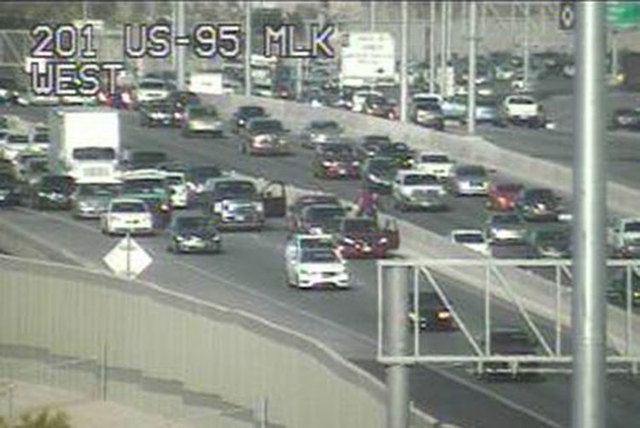RTC’s traffic cameras can be turned off after violent crashes
Live images of traffic-clogged freeways flashing on morning newscasts usually help motorists decide how to get to work.
The footage is captured on roughly 600 cameras mounted throughout the Las Vegas Valley, and readily shared by the Regional Transportation Commission of Southern Nevada.
But, as several local journalists recently learned, there are moments when the cameras need to go dark.
There are some images that just can’t — or shouldn’t — be seen by the general public.
“In general we’re looking at safety, we’re looking at human concern and we’re making real-time decisions,” Major Thom Jackson of the Nevada Highway Patrol told television, radio and newspaper reporters during an informal luncheon at the RTC’s traffic management center.
“I’d sense that we’d like to set down a set of hard and fast rules, and we’re not capable of that,” Jackson said. “There are too many variables and human behavior has too many facets, but we try to do our best.”
While each situation is unique, roadway camera footage is usually suppressed after high-speed accidents that result in death or injuries that are too graphic to show on TV or online, Jackson said.
The NHP also directs the camera to go dark if officers are in tactical positions, waiting out a barricaded or armed suspect. The same is true of high-profile motorcades, such as for the president.
“We just don’t want to give up our positions to suspects, or put someone in danger,” Jackson explained.
The meeting was called after Ken Smith, the morning traffic reporter for Fox 5 in Las Vegas, raised concerns that the cameras were going dark more often than usual. Smith’s argument was that the RTC’s traffic cameras were no different from footage shot by television crews or by people using their smartphones.
“We live in an age of transparency now,” Smith said. “We got cameras everywhere.”
The difference, however, is that these cameras are funded by taxpayers and extra precautions must be taken when releasing footage, RTC General Manager Tina Quigley said.
“Sometimes we have not done a really great job,” Quigley admitted. “Sometimes we have probably suppressed the cameras more aggressively than we needed to, and then sometimes we have forgotten to unsuppress them.”
To resolve those concerns, precise documentation on who called for camera suppression, the reason and the time, will be carefully logged, said Brian Hoeft, RTC’s director of Freeway and Arterial System of Transportation, known as FAST.
The agency, Hoeft said, will also work to improve communication with all local law enforcement agencies to determine when the footage can be publicly viewed again.
“We know it’s our job to be transparent,” Quigley said.
HOLLYWOOD IS ROUGH
Potholes and rough patches are a daily routine for Randy’s daily commute along Hollywood Boulevard, along with constant changes in the number of travel lanes.
“Is there a plan to improve Hollywood Boulevard, or am I out of luck because I live on the east side of the valley?” Randy inquired in an email sent to the Road Warrior. “I feel that if this road was on the more prestigious west side of the valley or in Summerlin, then it would have been improved years ago.”
Unfortunately, Randy, improvements to Hollywood Boulevard were delayed because trucks rumbled along the heavily-used road to haul equipment and materials during recent work on the Las Vegas Wash, Clark County spokesman Dan Kulin said.
“However, we have been diligent in filling any potholes that we became aware of on the road,” Kulin said.
Relief is in sight, Randy. Work is expected to start next year to rebuild sections of Hollywood Boulevard between Lake Mead and Charleston boulevards, Kulin said.
ALL-WAY STOP
Bernadette from Las Vegas noticed that all directions of traffic must now come to a full stop at the intersection of Desert Inn and Theme roads.
“I don’t understand why the county would do this here,” Bernadette wrote in an email to the Road Warrior. “There is only one lane of traffic in each direction. This is going to cause major delays.”
Clark County studied the intersection and determined the change could “improve safety without having a significant impact on traffic flow,” Kulin said.
County officials are keeping an eye on the intersection to see if any other adjustments need to be made.
Questions and comments should be sent to roadwarrior@reviewjournal.com. Please include your phone number. Follow the Road Warrior on Twitter: @RJroadwarrior






















